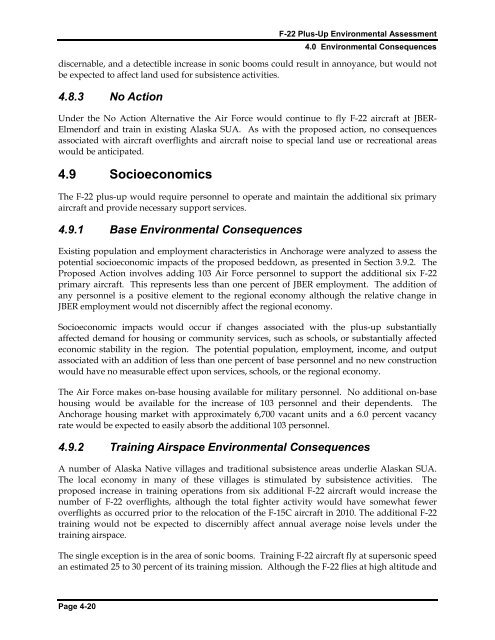F-22 Plus-Up Environmental Assessment - Joint Base Elmendorf ...
F-22 Plus-Up Environmental Assessment - Joint Base Elmendorf ...
F-22 Plus-Up Environmental Assessment - Joint Base Elmendorf ...
Create successful ePaper yourself
Turn your PDF publications into a flip-book with our unique Google optimized e-Paper software.
F-<strong>22</strong> <strong>Plus</strong>-<strong>Up</strong> <strong>Environmental</strong> <strong>Assessment</strong><br />
4.0 <strong>Environmental</strong> Consequences<br />
discernable, and a detectible increase in sonic booms could result in annoyance, but would not<br />
be expected to affect land used for subsistence activities.<br />
4.8.3 No Action<br />
Under the No Action Alternative the Air Force would continue to fly F-<strong>22</strong> aircraft at JBER-<br />
<strong>Elmendorf</strong> and train in existing Alaska SUA. As with the proposed action, no consequences<br />
associated with aircraft overflights and aircraft noise to special land use or recreational areas<br />
would be anticipated.<br />
4.9 Socioeconomics<br />
The F-<strong>22</strong> plus-up would require personnel to operate and maintain the additional six primary<br />
aircraft and provide necessary support services.<br />
4.9.1 <strong>Base</strong> <strong>Environmental</strong> Consequences<br />
Existing population and employment characteristics in Anchorage were analyzed to assess the<br />
potential socioeconomic impacts of the proposed beddown, as presented in Section 3.9.2. The<br />
Proposed Action involves adding 103 Air Force personnel to support the additional six F-<strong>22</strong><br />
primary aircraft. This represents less than one percent of JBER employment. The addition of<br />
any personnel is a positive element to the regional economy although the relative change in<br />
JBER employment would not discernibly affect the regional economy.<br />
Socioeconomic impacts would occur if changes associated with the plus-up substantially<br />
affected demand for housing or community services, such as schools, or substantially affected<br />
economic stability in the region. The potential population, employment, income, and output<br />
associated with an addition of less than one percent of base personnel and no new construction<br />
would have no measurable effect upon services, schools, or the regional economy.<br />
The Air Force makes on-base housing available for military personnel. No additional on-base<br />
housing would be available for the increase of 103 personnel and their dependents. The<br />
Anchorage housing market with approximately 6,700 vacant units and a 6.0 percent vacancy<br />
rate would be expected to easily absorb the additional 103 personnel.<br />
4.9.2 Training Airspace <strong>Environmental</strong> Consequences<br />
A number of Alaska Native villages and traditional subsistence areas underlie Alaskan SUA.<br />
The local economy in many of these villages is stimulated by subsistence activities. The<br />
proposed increase in training operations from six additional F-<strong>22</strong> aircraft would increase the<br />
number of F-<strong>22</strong> overflights, although the total fighter activity would have somewhat fewer<br />
overflights as occurred prior to the relocation of the F-15C aircraft in 2010. The additional F-<strong>22</strong><br />
training would not be expected to discernibly affect annual average noise levels under the<br />
training airspace.<br />
The single exception is in the area of sonic booms. Training F-<strong>22</strong> aircraft fly at supersonic speed<br />
an estimated 25 to 30 percent of its training mission. Although the F-<strong>22</strong> flies at high altitude and<br />
Page 4-20
















